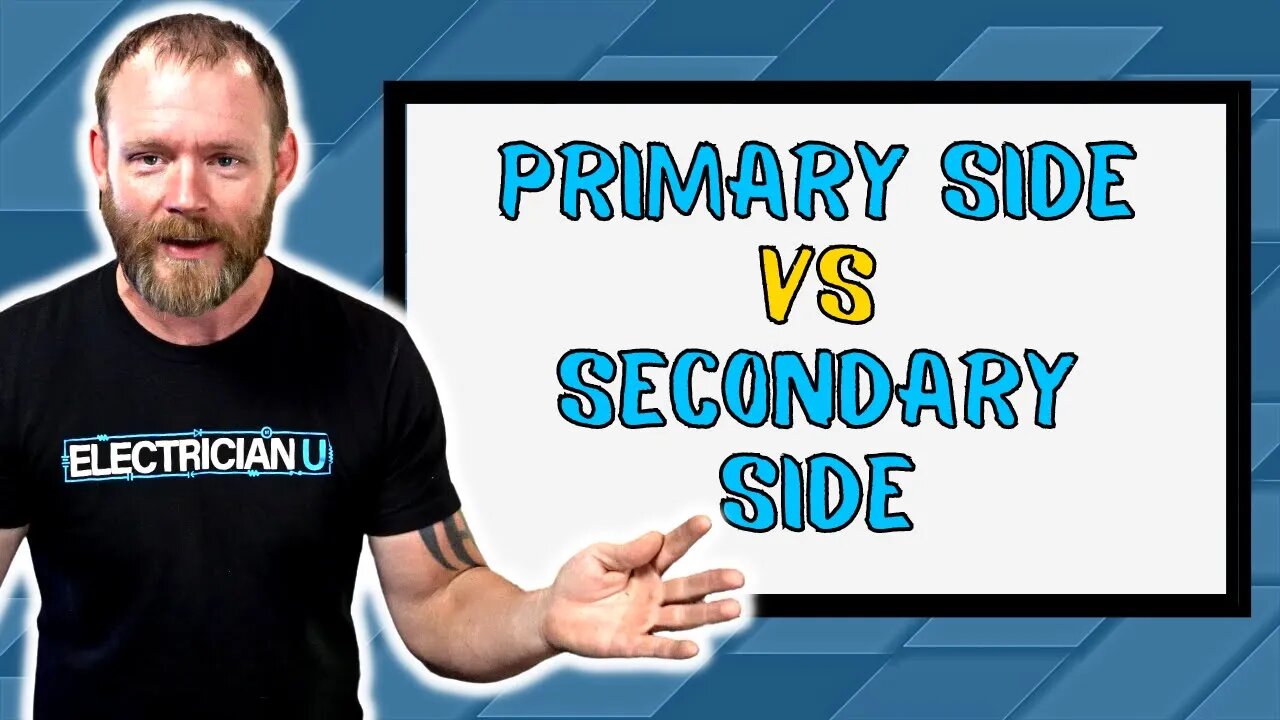Premium Only Content

What is the Primary Side vs the Secondary Side of an Electrical Service?
Join this channel to get access to perks:
https://www.youtube.com/channel/UCB3jUEyCLRbCw7QED0vnXYg/join
One of the things that many new electricians (even veteran electricians) struggle with wrapping their heads around is how a transformer works and what is the difference between the primary and secondary side is. Seems like it is just some voodoo magic! In today’s episode of Electrician U, Dustin dives in and gives some explanation to how it all works.
🤘⚡️MEMBERSHIP⚡️🤘
JOIN ELECTRICIAN U - become a member and get:
FREE Continuing Education every year
FREE Practice Exams
FREE Monthly Video Courses
FREE Weekly Live Instructor-Led Classes
FREE Monthly Educational Newsletter
Premium Members-Only Content
Private Discord Channel
Monthly Members-Only Discord Chats
Sign up here --- https://www.electricianu.com/electrician-u-membership/
🎧🎹MUSIC AND VIDEO:🎹🎧
https://www.facebook.com/descantmv
🎬✍️ART AND ILLUSTRATION:✍️🎬
https://www.daverussoart.com
A primary transformer is simply a piece of equipment that the utility company uses to step down their voltage to a usable level in a building. It could be any building- a residence, a 3-story commercial building, or a sprawling industrial site. The voltage that the utility uses is generally MUCH too high for us to be able to utilize in almost all building types and requires it to be stepped down to a usable range.
Remembering from previous discussions that electricity travels in complete loops. Transformers are no different. The cool thing about transformers is that it uses the relationship between the electrons and magnetism to do its thing! At the utility plant there is some type of generator starting the process. Wires leave the generator (whether it’s a coal fired type generator, a wind generator, even a nuclear generator) goes thru one side of the windings of a transformer, and back to the generator creating a loop. The voltage that is operating at this stage is very high probably at the 150kv range! Within the first transformer (or transmission type of transformer) there is a secondary coil that isn’t necessarily touching the primary coil, but the electrons get moving by the magnetic fields caused by the first coil and a different voltage is produced on this secondary side- probably in the neighborhood of 7200v. this is considered a distribution voltage range. Still too high for normal mortals to utilize but can be run thru neighborhoods to distribute to either the pad mounted transformers on the ground (those green boxes you see when driving along) or the pole mounted transformers. But we are still not quite done yet!
From those distribution transformers, again, there is a primary and a secondary coil in it. The primary coil is a complete loop between the previous transformer (the transmission transformer) and the secondary coil is a complete loop between the transformer and the building it is serving. As electricians, when we set a panel, we are simply putting it in the middle of that last loop! We don’t normally have the wires from the transformer going straight to the load, but rather have a panel in between the phases so we can control things and turn things on and off as needed. Again, electricity travels in loops, and once we understand that concept, things tend to become much clearer on how electricity works!
A closely related question would be what is the difference between the pole mounted transformers and the green pad mounted transformers we see in newer or higher end areas. Nothing really- its just a different way for us to get power down to a useable level! The pole mounted transformer system is considerably cheaper and easier to install. Drill holes in the ground to slide the pole in, sling some wires in between the poles and voila! But you do end up with the unsightly poles/wires to be seen by everyone. The pad mounted type is much more pleasing to the eye but requires considerably more labor. The ground must be dug out or horizontally drilled, conduit must be installed, trenches must be backfilled and THEN the wire can be run in between. Again, considerably more labor intensive, but much more pleasing to the eye. In addition, it also keeps the wire out of the effects of weather and away from the general population!
We hope this has been an insightful look into the primary and secondary sides of a transformer. Is there a topic you would like to see discussed on Electrician U? Leave us a comment in the comments section and let us know. Please continue to follow Dustin and Electrician U as we are constantly updating our content to assist our followers in becoming the best electricians that they can be.
#electrician #electrical #electricity #primary #secondary #side #service
-
 0:58
0:58
Electrician U
1 year agoFISH STICKS! Every electrician needs these!
5.87K -
 0:48
0:48
TXLacs
2 years agoPrimary 2 Secondary diy
22 -
 0:20
0:20
TXLacs
2 years agoPrimary to Secondary
22 -
 0:39
0:39
KMGH
1 year agoElectrical Workers Minority Caucus Day of Service in Denver
7 -
 11:12
11:12
The Great American Reset
2 years agoErik Carlson's Primary & Secondary narratives
19 -
 3:12
3:12
Simple Answers to Good Political Questions
2 years agoWhat is a primary election?
13 -
 2:46
2:46
fogglake
1 year agoWhat is primary water
16 -
 1:45:48
1:45:48
BettsMinistriesSermons
2 years agoPrimary Belief VS Secondary Belief Oct 25, 2021
7 -
 18:59
18:59
Fit'n Fire
12 hours ago $5.13 earnedZenith ZF5 The Best MP5 Clone available
35.5K1 -
 58:34
58:34
Rethinking the Dollar
21 hours agoTrump Faces 'Big Mess' Ahead | RTD News Update
31.2K5